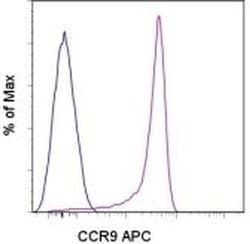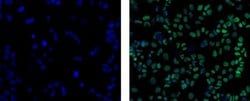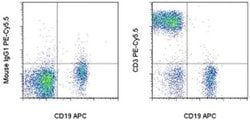50-112-8764
CD199 (CCR9) Monoclonal Antibody (eBioCW-1.2 (CW-1.2)), APC, eBioscience™, Invitrogen™
Manufacturer: Fischer Scientific
Select a Size
| Pack Size | SKU | Availability | Price |
|---|---|---|---|
| Each of 1 | 50-112-8764-Each-of-1 | In Stock | ₹ 37,202.00 |
50-112-8764 - Each of 1
In Stock
Quantity
1
Base Price: ₹ 37,202.00
GST (18%): ₹ 6,696.36
Total Price: ₹ 43,898.36
Antigen
CD199 (CCR9)
Classification
Monoclonal
Concentration
0.2 mg/mL
Formulation
PBS with 0.09% sodium azide; pH 7.2
Gene Accession No.
Q9WUT7
Gene Symbols
Ccr9
Purification Method
Affinity chromatography
Regulatory Status
RUO
Gene ID (Entrez)
12769
Content And Storage
4° C, store in dark, DO NOT FREEZE!
Form
Liquid
Applications
Flow Cytometry
Clone
eBioCW-1.2 (CW-1.2)
Conjugate
APC
Gene
Ccr9
Gene Alias
A130091K22Rik; C-C chemokine receptor type 9; C-C CKR-9; C-C motif chemokine receptor 9; CC-CKR-9; Ccr9; CCR-9; CDw199; CDw199 antigen; chemokine (C-C motif) receptor 9; chemokine C-C receptor 10; Cmkbr10; G protein-coupled receptor 28; GPR28; GPR-9-6; G-protein coupled receptor 28
Host Species
Mouse
Quantity
100 μg
Primary or Secondary
Primary
Target Species
Mouse
Product Type
Antibody
Isotype
IgG2a
Description
- Description: The eBioCW-1.2 monoclonal antibody reacts with mouse CCR9 (CD199), which is the receptor for thymus-expressed chemokine (TECK)
- CCR9 is a member of the G protein coupled receptor (GPCR) supergene family, and is involved in trafficking of T cell progenitors within the thymus
- CCR9 expression during thymocyte development commences at the double-negative (DN) 3 stage (CD4-CD8-CD25+CD44-), peaks in the double-positive (DP) stage (CD4+CD8+CD25-CD44-), and is down-regulated in commited CD4+ or CD8+ single-positive (SP) thymoyctes
- CCR9-deficient mice show a mild impairment in thymoycte development
- In the periphery, CCR9 is thought to be expressed on naive CD8+ T cells, but not on naive CD4+ T cells
- Applications Reported: This eBioCW-1.2 (CW-1.2) antibody has been reported for use in flow cytometric analysis
- Applications Tested: This eBioCW-1.2 (CW-1.2) antibody has been tested by flow cytometric analysis of mouse thymocytes
- This can be used at less than or equal to 0.25 μg per million cells in a 100 μL total staining volume
- It is recommended that the antibody be carefully titrated for optimal performance in the assay of interest
- Excitation: 633-647 nm; Emission: 660 nm; Laser: Red Laser
- Filtration: 0.2 μm post-manufacturing filtered
- The protein encoded by this gene is a member of the beta chemokine receptor family
- It is predicted to be a seven transmembrane protein similar to G protein-coupled receptors
- Chemokines and their receptors are key regulators of the thymocytes migration and maturation in normal and inflammation conditions
- The specific ligand of this receptor is CCL25
- It has been found that this gene is differentially expressed by T lymphocytes of small intestine and colon, suggested a role in the thymocytes recruitment and development that may permit functional specialization of immune responses in different segment of the gastrointestinal tract
- This gene is mapped to the chemokine receptor gene cluster region
- Two alternatively spliced transcript variants have been described.
Compare Similar Items
Show Difference
Antigen: CD199 (CCR9)
Classification: Monoclonal
Concentration: 0.2 mg/mL
Formulation: PBS with 0.09% sodium azide; pH 7.2
Gene Accession No.: Q9WUT7
Gene Symbols: Ccr9
Purification Method: Affinity chromatography
Regulatory Status: RUO
Gene ID (Entrez): 12769
Content And Storage: 4° C, store in dark, DO NOT FREEZE!
Form: Liquid
Applications: Flow Cytometry
Clone: eBioCW-1.2 (CW-1.2)
Conjugate: APC
Gene: Ccr9
Gene Alias: A130091K22Rik; C-C chemokine receptor type 9; C-C CKR-9; C-C motif chemokine receptor 9; CC-CKR-9; Ccr9; CCR-9; CDw199; CDw199 antigen; chemokine (C-C motif) receptor 9; chemokine C-C receptor 10; Cmkbr10; G protein-coupled receptor 28; GPR28; GPR-9-6; G-protein coupled receptor 28
Host Species: Mouse
Quantity: 100 μg
Primary or Secondary: Primary
Target Species: Mouse
Product Type: Antibody
Isotype: IgG2a
Antigen:
CD199 (CCR9)
Classification:
Monoclonal
Concentration:
0.2 mg/mL
Formulation:
PBS with 0.09% sodium azide; pH 7.2
Gene Accession No.:
Q9WUT7
Gene Symbols:
Ccr9
Purification Method:
Affinity chromatography
Regulatory Status:
RUO
Gene ID (Entrez):
12769
Content And Storage:
4° C, store in dark, DO NOT FREEZE!
Form:
Liquid
Applications:
Flow Cytometry
Clone:
eBioCW-1.2 (CW-1.2)
Conjugate:
APC
Gene:
Ccr9
Gene Alias:
A130091K22Rik; C-C chemokine receptor type 9; C-C CKR-9; C-C motif chemokine receptor 9; CC-CKR-9; Ccr9; CCR-9; CDw199; CDw199 antigen; chemokine (C-C motif) receptor 9; chemokine C-C receptor 10; Cmkbr10; G protein-coupled receptor 28; GPR28; GPR-9-6; G-protein coupled receptor 28
Host Species:
Mouse
Quantity:
100 μg
Primary or Secondary:
Primary
Target Species:
Mouse
Product Type:
Antibody
Isotype:
IgG2a
Antigen: SOX2
Classification: Monoclonal
Concentration: 0.5 mg/mL
Formulation: PBS with 0.09% sodium azide; pH 7.2
Gene Accession No.: P48431, P48432
Gene Symbols: SOX2
Purification Method: Affinity chromatography
Regulatory Status: RUO
Gene ID (Entrez): 20674, 6657
Content And Storage: 4° C, store in dark, DO NOT FREEZE!
Form: Liquid
Applications: Flow Cytometry, Immunocytochemistry, Immunohistochemistry (Frozen), Immunohistochemistry (Paraffin)
Clone: Btjce
Conjugate: Alexa Fluor 488
Gene: SOX2
Gene Alias: ANOP3; cb236; Delta EF2a; lcc; MCOPS3; MCOPS3 (Microphthalmia Syndromic type 3); RGD1565646; sex determining region Y-box 2; SOX 2; SOX2; Sox-2; soxp; SRY (sex determining region Y) box 2; SRY (sex determining region Y)-box 2; SRY box 2; SRY related HMG box 2; SRY-box 2; SRY-box 2; SOX2; SRY-box containing gene 2; SRY-box transcription factor 2; SRY-related HMG-box gene 2; transcription factor SOX2; transcription factor SOX-2; wu:fb83g04; wu:fc14d07; ysb; zgc:65860; zgc:77389
Host Species: Rat
Quantity: 25 μg
Primary or Secondary: Primary
Target Species: Human, Mouse
Product Type: Antibody
Isotype: IgG2a κ
Antigen:
SOX2
Classification:
Monoclonal
Concentration:
0.5 mg/mL
Formulation:
PBS with 0.09% sodium azide; pH 7.2
Gene Accession No.:
P48431, P48432
Gene Symbols:
SOX2
Purification Method:
Affinity chromatography
Regulatory Status:
RUO
Gene ID (Entrez):
20674, 6657
Content And Storage:
4° C, store in dark, DO NOT FREEZE!
Form:
Liquid
Applications:
Flow Cytometry, Immunocytochemistry, Immunohistochemistry (Frozen), Immunohistochemistry (Paraffin)
Clone:
Btjce
Conjugate:
Alexa Fluor 488
Gene:
SOX2
Gene Alias:
ANOP3; cb236; Delta EF2a; lcc; MCOPS3; MCOPS3 (Microphthalmia Syndromic type 3); RGD1565646; sex determining region Y-box 2; SOX 2; SOX2; Sox-2; soxp; SRY (sex determining region Y) box 2; SRY (sex determining region Y)-box 2; SRY box 2; SRY related HMG box 2; SRY-box 2; SRY-box 2; SOX2; SRY-box containing gene 2; SRY-box transcription factor 2; SRY-related HMG-box gene 2; transcription factor SOX2; transcription factor SOX-2; wu:fb83g04; wu:fc14d07; ysb; zgc:65860; zgc:77389
Host Species:
Rat
Quantity:
25 μg
Primary or Secondary:
Primary
Target Species:
Human, Mouse
Product Type:
Antibody
Isotype:
IgG2a κ
Antigen: TIGIT
Classification: Monoclonal
Concentration: 0.2 mg/mL
Formulation: PBS with 0.09% sodium azide; pH 7.2
Gene Accession No.: P86176
Gene Symbols: TIGIT
Purification Method: Affinity chromatography
Regulatory Status: RUO
Gene ID (Entrez): 100043314
Content And Storage: 4° C, store in dark, DO NOT FREEZE!
Form: Liquid
Applications: Flow Cytometry
Clone: GIGD7
Conjugate: PerCP-eFluor 710
Gene: TIGIT
Gene Alias: ENSMUSG00000071552; T cell immunoreceptor with Ig and ITIM domains; T-cell immunoreceptor with Ig and ITIM domains; TIGIT; V-set and immunoglobulin domain containing 9; V-set and immunoglobulin domain-containing protein 9; V-set and transmembrane domain containing 3; V-set and transmembrane domain-containing protein 3; VSIG9; VSTM3; Washington University cell adhesion molecule; WUCAM
Host Species: Rat
Quantity: 100 μg
Primary or Secondary: Primary
Target Species: Mouse
Product Type: Antibody
Isotype: IgG2a κ
Antigen:
TIGIT
Classification:
Monoclonal
Concentration:
0.2 mg/mL
Formulation:
PBS with 0.09% sodium azide; pH 7.2
Gene Accession No.:
P86176
Gene Symbols:
TIGIT
Purification Method:
Affinity chromatography
Regulatory Status:
RUO
Gene ID (Entrez):
100043314
Content And Storage:
4° C, store in dark, DO NOT FREEZE!
Form:
Liquid
Applications:
Flow Cytometry
Clone:
GIGD7
Conjugate:
PerCP-eFluor 710
Gene:
TIGIT
Gene Alias:
ENSMUSG00000071552; T cell immunoreceptor with Ig and ITIM domains; T-cell immunoreceptor with Ig and ITIM domains; TIGIT; V-set and immunoglobulin domain containing 9; V-set and immunoglobulin domain-containing protein 9; V-set and transmembrane domain containing 3; V-set and transmembrane domain-containing protein 3; VSIG9; VSTM3; Washington University cell adhesion molecule; WUCAM
Host Species:
Rat
Quantity:
100 μg
Primary or Secondary:
Primary
Target Species:
Mouse
Product Type:
Antibody
Isotype:
IgG2a κ
Antigen: CD3
Classification: Monoclonal
Concentration: 5 μL/Test
Formulation: PBS with 0.2% BSA and 0.09% sodium azide; pH 7.2
Gene Accession No.: P04234, P07766, P09693, P20963
Gene Symbols: Cd247, Cd3d, CD3E, CD3g
Purification Method: Affinity chromatography
Regulatory Status: RUO
Gene ID (Entrez): 451584, 451585, 742330, 748272, 915, 916, 917, 919
Content And Storage: 4° C, store in dark, DO NOT FREEZE!
Form: Liquid
Applications: Flow Cytometry
Clone: SK7
Conjugate: PE-Cyanine5.5
Gene: CD3g
Gene Alias: 4930549J05Rik; A430104F18Rik; AI504783; antigen CD3D, delta polypeptide (TiT3 complex); antigen CD3E, epsilon polypeptide (TiT3 complex); antigen CD3G, gamma polypeptide; antigen CD3Z, zeta polypeptide; AW552088; Cd247; CD247 antigen; CD247 antigen, zeta subunit; Cd247 molecule; CD3; CD3 antigen delta chain; CD3 antigen delta polypeptide; CD3 antigen gamma chain; CD3 antigen, delta polypeptide; CD3 antigen, delta subunit; CD3 antigen, epsilon polypeptide; CD3 antigen, gamma polypeptide; CD3 antigen, zeta polypeptide; CD3 delta; CD3 epsilon; CD3 epsilon chain; CD3 epsilon subunit; CD3 epsilon subunit precursor; CD3 gamma-chain; CD3 glycoprotein; CD3 glycoprotein precursor; CD3 molecule delta polypeptide; CD3 molecule, delta; CD3 molecule, epsilon; CD3 molecule, epsilon polypeptide; CD3 molecule, gamma; CD3 molecule, gamma polypeptide; CD3 protein; CD3 TCR complex; CD3 type I transmembrane glycoprotein; CD3 type I transmembrane glycoprotein precursor; CD3 zeta chain; Cd3d; CD3D antigen delta; CD3D antigen, delta polypeptide (TiT3 complex); CD3d molecule; CD3d molecule, delta (CD3-TCR complex); CD3-DELTA; Cd3e; CD3E antigen, epsilon polypeptide; CD3E antigen, epsilon polypeptide (TiT3 complex); CD3e molecule; CD3e molecule, epsilon (CD3-TCR complex); CD3epsilon; CD3-epsilon; Cd3-eta; Cd3g; CD3G antigen, gamma polypeptide; CD3g antigen, gamma polypeptide (TiT3 complex); CD3g molecule; CD3g molecule, epsilon (CD3-TCR complex); CD3g molecule, gamma (CD3-TCR complex); CD3-GAMMA; Cd3h; CD3Q; Cd3z; CD3Z antigen, zeta polypeptide (TiT3 complex); Cd3zeta; Cd3-zeta; CD3zeta chain; CD3-zeta/eta; Ctg3; Ctg-3; FLJ18683; IMD17; IMD18; IMD19; IMD25; Leu-4; OKT3, delta chain; T cell antigen receptor complex epsilon subunit of T3; T3/TCR complex; T3d; T3e; T3g; T3Z; T-cell antigen receptor complex, epsilon subunit of T3; T-cell antigen receptor complex, gamma subunit of T3; T-cell antigen receptor complex, zeta subunit of CD3; T-cell receptor CD3 epsilon chain; T-cell receptor CD3 epsilon subunit; T-cell receptor CD3 subunit zeta; T-cell receptor CD3, subunit zeta; T-cell receptor T3 delta chain; T-cell receptor T3 eta chain; T-cell receptor T3 gamma chain; T-cell receptor T3 zeta chain; T-cell receptor zeta chain; T-cell surface antigen T3/Leu-4 epsilon chain; T-cell surface glycoprotein CD3 delta chain; T-cell surface glycoprotein CD3 epsilon chain; T-cell surface glycoprotein CD3 gamma chain; T-cell surface glycoprotein CD3 zeta chain; T-cell surface protein; TcR CD3 delta-chain; TcR CD3 gamma-chain; TCR zeta chain; TCR zeta chain subunit; TCRE; Tcrk; TCRZ; TCRzeta; TiT3 complex; type I transmembrane protein; T-cell surface molecule CD3
Host Species: Mouse
Quantity: 100 Tests
Primary or Secondary: Primary
Target Species: Chimpanzee, Human
Product Type: Antibody
Isotype: IgG1 κ
Antigen:
CD3
Classification:
Monoclonal
Concentration:
5 μL/Test
Formulation:
PBS with 0.2% BSA and 0.09% sodium azide; pH 7.2
Gene Accession No.:
P04234, P07766, P09693, P20963
Gene Symbols:
Cd247, Cd3d, CD3E, CD3g
Purification Method:
Affinity chromatography
Regulatory Status:
RUO
Gene ID (Entrez):
451584, 451585, 742330, 748272, 915, 916, 917, 919
Content And Storage:
4° C, store in dark, DO NOT FREEZE!
Form:
Liquid
Applications:
Flow Cytometry
Clone:
SK7
Conjugate:
PE-Cyanine5.5
Gene:
CD3g
Gene Alias:
4930549J05Rik; A430104F18Rik; AI504783; antigen CD3D, delta polypeptide (TiT3 complex); antigen CD3E, epsilon polypeptide (TiT3 complex); antigen CD3G, gamma polypeptide; antigen CD3Z, zeta polypeptide; AW552088; Cd247; CD247 antigen; CD247 antigen, zeta subunit; Cd247 molecule; CD3; CD3 antigen delta chain; CD3 antigen delta polypeptide; CD3 antigen gamma chain; CD3 antigen, delta polypeptide; CD3 antigen, delta subunit; CD3 antigen, epsilon polypeptide; CD3 antigen, gamma polypeptide; CD3 antigen, zeta polypeptide; CD3 delta; CD3 epsilon; CD3 epsilon chain; CD3 epsilon subunit; CD3 epsilon subunit precursor; CD3 gamma-chain; CD3 glycoprotein; CD3 glycoprotein precursor; CD3 molecule delta polypeptide; CD3 molecule, delta; CD3 molecule, epsilon; CD3 molecule, epsilon polypeptide; CD3 molecule, gamma; CD3 molecule, gamma polypeptide; CD3 protein; CD3 TCR complex; CD3 type I transmembrane glycoprotein; CD3 type I transmembrane glycoprotein precursor; CD3 zeta chain; Cd3d; CD3D antigen delta; CD3D antigen, delta polypeptide (TiT3 complex); CD3d molecule; CD3d molecule, delta (CD3-TCR complex); CD3-DELTA; Cd3e; CD3E antigen, epsilon polypeptide; CD3E antigen, epsilon polypeptide (TiT3 complex); CD3e molecule; CD3e molecule, epsilon (CD3-TCR complex); CD3epsilon; CD3-epsilon; Cd3-eta; Cd3g; CD3G antigen, gamma polypeptide; CD3g antigen, gamma polypeptide (TiT3 complex); CD3g molecule; CD3g molecule, epsilon (CD3-TCR complex); CD3g molecule, gamma (CD3-TCR complex); CD3-GAMMA; Cd3h; CD3Q; Cd3z; CD3Z antigen, zeta polypeptide (TiT3 complex); Cd3zeta; Cd3-zeta; CD3zeta chain; CD3-zeta/eta; Ctg3; Ctg-3; FLJ18683; IMD17; IMD18; IMD19; IMD25; Leu-4; OKT3, delta chain; T cell antigen receptor complex epsilon subunit of T3; T3/TCR complex; T3d; T3e; T3g; T3Z; T-cell antigen receptor complex, epsilon subunit of T3; T-cell antigen receptor complex, gamma subunit of T3; T-cell antigen receptor complex, zeta subunit of CD3; T-cell receptor CD3 epsilon chain; T-cell receptor CD3 epsilon subunit; T-cell receptor CD3 subunit zeta; T-cell receptor CD3, subunit zeta; T-cell receptor T3 delta chain; T-cell receptor T3 eta chain; T-cell receptor T3 gamma chain; T-cell receptor T3 zeta chain; T-cell receptor zeta chain; T-cell surface antigen T3/Leu-4 epsilon chain; T-cell surface glycoprotein CD3 delta chain; T-cell surface glycoprotein CD3 epsilon chain; T-cell surface glycoprotein CD3 gamma chain; T-cell surface glycoprotein CD3 zeta chain; T-cell surface protein; TcR CD3 delta-chain; TcR CD3 gamma-chain; TCR zeta chain; TCR zeta chain subunit; TCRE; Tcrk; TCRZ; TCRzeta; TiT3 complex; type I transmembrane protein; T-cell surface molecule CD3
Host Species:
Mouse
Quantity:
100 Tests
Primary or Secondary:
Primary
Target Species:
Chimpanzee, Human
Product Type:
Antibody
Isotype:
IgG1 κ



